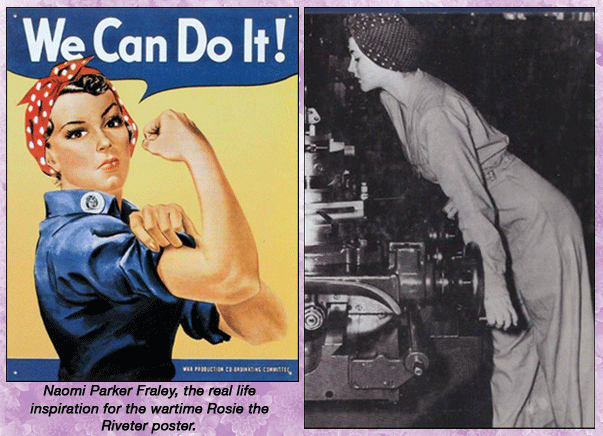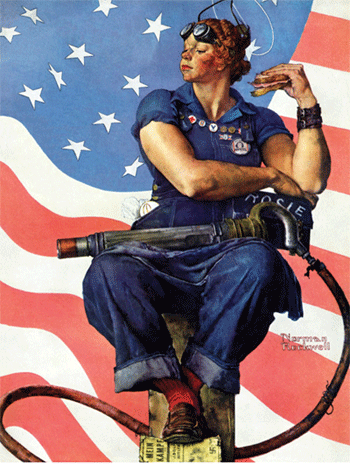|
 Rosie
the Riveter has died. Rosalind P. Walter, also known as “Rosie
the Riveter,” passed away on March 4, 2020, in New York City.
She was 95 years old. Rosie
the Riveter has died. Rosalind P. Walter, also known as “Rosie
the Riveter,” passed away on March 4, 2020, in New York City.
She was 95 years old.
In the early years of WWII, Rosalind
worked the night shift at a plant in Connecticut, driving rivets
into F-4U Corsair fighter planes (incidentally, my paternal grandfather
flew the same model aircraft in the war). Her work inspired Redd
Evans and John Jacob Loeb to write the song “Rosie the Riveter”
in 1943. Rosalind went on to serve on several boards—the International
Tennis Hall of Fame, the Museum of Natural History, the North Shore
Wildlife Sanctuary, Long Island University, the Paley Center for
Media, and others. She was also a lifelong philanthropist, supporting
organizations like PBS, the Piermont Morgan Library, and WNET in
New York.
 |
In 2018, we lost Naomi Parker Fraley,
the physical inspiration for the wartime Rosie the Riveter poster.
When she was just twenty years old, Naomi began working at the Naval
Air Station in Alameda, California. She and her 18-year-old sister,
Ada, worked in the machine shop. An Acme photographer snapped a
picture of Naomi at her lathe, her hair secured in the polka-dot
scarf that would become one of Rosie’s signatures. A short
while later, J. Howard Miller’s famous industrial poster was
born.
 Over the years, several Rosies have
come forward to claim they were the original “Rosie the Riveter.”
A Michigan woman named Geraldine Hoff Doyle who worked as a metal
presser believed she may have been the inspiration for Rosie, having
also had her picture taken while working at her machine. Norman
Rockwell found his Rosie in a 19-year-old phone operator named Mary
Doyle Keefe. He painted her for the cover of the May 29, 1943, edition
of the Saturday Evening Post. Over the years, several Rosies have
come forward to claim they were the original “Rosie the Riveter.”
A Michigan woman named Geraldine Hoff Doyle who worked as a metal
presser believed she may have been the inspiration for Rosie, having
also had her picture taken while working at her machine. Norman
Rockwell found his Rosie in a 19-year-old phone operator named Mary
Doyle Keefe. He painted her for the cover of the May 29, 1943, edition
of the Saturday Evening Post.
One could assert that all of their
claims are correct. They were all Rosie the Riveter, as were thousands
of women who left their homes to work in factories across the nation
during the war.
Rosalind P. “Rosie the Riveter”
Walter died on March 4, 2020. A day later, Elizabeth Warren withdrew
from the Democratic Presidential race. The synchronicity felt disheartening.
“We Can Do It!” Can we? However you may have felt about
Warren as a candidate, it was thrilling to watch a woman dominate
a debate stage and drum up so much spirited support. I remember
in the 2016 run when so many people said they would never support
Hillary—that someone like Warren was a better option. That
had it been Warren instead of Hillary, Democrats might have won in
2016. Now, looking at the last few months, I wonder at the sincerity
behind all those sentiments. I can’t shake the feeling that
in 2020, the electorate still considers the presidency of the United
States to be a man’s job in the same way factory work was
once considered the province of men.
 Over
the course of her campaign, whenever Senator Warren met a young
girl at an event, she would lock eyes and a single pinky with the
youth and say, “Hi, my name is Elizabeth and I’m running
for president, because that’s what girls do.” And she
would make the girl promise to always remember: That’s what
girls do—they run for president. When Senator Warren dropped
out of the campaign, she said, “One of the hardest parts of
this is all the pinky promises and all those little girls who are
going to have to wait for four more years.” Over
the course of her campaign, whenever Senator Warren met a young
girl at an event, she would lock eyes and a single pinky with the
youth and say, “Hi, my name is Elizabeth and I’m running
for president, because that’s what girls do.” And she
would make the girl promise to always remember: That’s what
girls do—they run for president. When Senator Warren dropped
out of the campaign, she said, “One of the hardest parts of
this is all the pinky promises and all those little girls who are
going to have to wait for four more years.”
To all the women reading this: you
are a Rosie and an Elizabeth; you hold within you infinite potentialities
that have nothing to do with gender. Those pinky promises were so
many seeds planted. We will see a woman in the White House. We Can
Do It.
Flossie Arend
|




 Vol.
19 No. 17
Vol.
19 No. 17